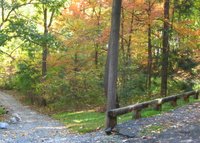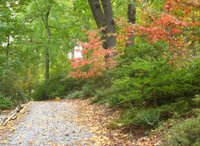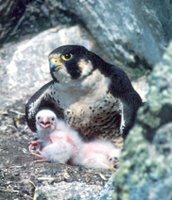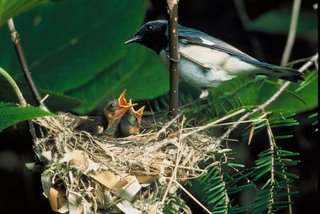As Halloween is upon us, our thoughts turn to birds with spooky reputations. Owls, because of their nocturnal habits and otherworldly calls, are a Halloween staple. Vultures, with their preference for carrion, are a harbinger of death. Few birds seems as ominous as crows and ravens. Like vultures, their plumage is funereal black and they will eat carrion. Crows will gather in large flocks to roost; such roosts may hold hundreds or thousands of birds. Their reputation is such that the collective name for a gathering of crows is a "murder" and that for ravens is an "unkindness." These dark birds are sometimes symbols for impending death, as in Edgar Allen Poe's The Raven:
| But the Raven still beguiling all my fancy into smiling, | |
| Straight I wheeled a cushioned seat in front of bird and bust and door; | |
| Then, upon the velvet sinking, I betook myself to linking | |
| Fancy unto fancy, thinking what this ominous bird of yore, | 70 |
| What this grim, ungainly, ghastly, gaunt, and ominous bird of yore | |
| Meant in croaking "Nevermore." |
Crows and ravens are part of the family Corvidae. In North America, this family also includes jays and magpies in addition to its larger, darker members. Despite the familiar fable, members of this family are among the most intelligent of birds. They are known to use strategems to acquire food; jays, for example, will lure smaller songbirds away from their nests with imitations of hawk calls. Some studies suggest intelligence on the level of great apes. Crow intelligence is the reason that attempts to scare these birds from farms and gardens rarely work for long.
The Mid-Atlantic region boasts three of these large, black birds: the American Crow, the Fish Crow, and the Common Raven. American Crows may be found throughout the region; these are the common crows whose caws may be heard in almost any neighborhood. Fish Crows are birds of the coastal plain. They may be found in marshes and along rivers; their distinctive call is a nasal nuh-uh. Common Ravens inhabit the western mountainous provinces; they may be found as far east as the piedmont, but rarely. They have wedge-shaped tails and emit a deep croaking sound instead of a caw. (This is not to be confused with a guttural croaking noise that American Crows sometimes make.)
Unfortunately, our local crow population have been hit hard by the outbreak of West Nile Virus. American Crows seem to be particularly susceptible, but corvids as a group suffer a higher death rate when exposed to the virus. The graph below, derived from Christmas Bird Count results in the DC area, gives a sense of their decline in the past decade.
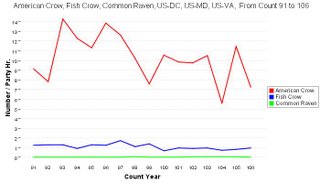 Because of recent worries about West Nile Virus and highly-pathogenic poultry flu in humans, crows again are becoming ominous signs. Only now, it is the dead crows rather than the living ones that are a cause for worry. With both diseases, birds are under a greater threat than humans.
Because of recent worries about West Nile Virus and highly-pathogenic poultry flu in humans, crows again are becoming ominous signs. Only now, it is the dead crows rather than the living ones that are a cause for worry. With both diseases, birds are under a greater threat than humans.Note: Audubon at Home has some good suggestions for making Halloween less wasteful.
Crossposted at Blue Ridge Gazette.








